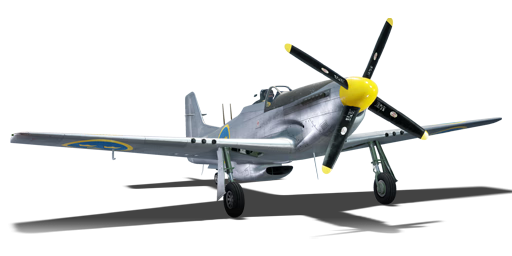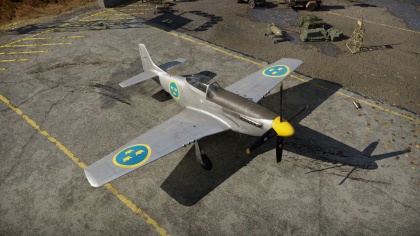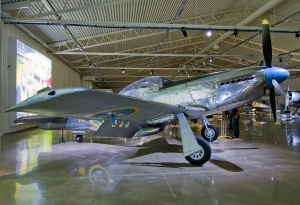J26
Contents
| This page is about the Swedish fighter J26. For other versions of this plane model, see P-51 (Family). |
Description
The J26 is a rank III Swedish fighter
with a battle rating of 3.7 (AB), 4.0 (RB), and 5.0 (SB). It was introduced in Update 1.95 "Northern Wind". This aircraft is the American P-51D-20-NA Mustang which was purchased by Sweden and given native markings.
General info
Flight performance
The J26 is a very fast and quite agile plane, it is one of the fastest fighters at its Battle Rating. Thanks to the higher engine settings and the use of the 150 octane fuel, it can easily reach 610 km/h at the sea level and 710 km/h at the optimal altitude. By average it is 20 km/h faster than the D-5 and, just like that variant, it has a really high dive speed limit. The climb rate, while not being as good as in the German interceptors, is quite good compared to previous planes from the American tech tree, climbing from the sea level to 5000 m altitude in over 4 minutes. Acceleration in a level flight is quite decent, it is comparable to the P-38 series and better than in any P-47. The addition of the dorsal fin makes the P-51D-10 more stable in yaw axis compared to the previous variant. Turn rate of both those planes is still almost the same. At low speed it is quite bad, but as soon as the plane gets faster it also starts to turn tighter, even at a really high speed near the maximum allowed speed.
The stall characteristics in the Mustang depends a lot on its fuel load, it is really hard to stall out while turning at the lowest one and is able to fly at almost full elevator deflection. On the other hand, it stalls quite fast with full fuel tanks, also it gets less stable after loading it with more than 30 minutes of fuel. The plane reaches its critical angle of attack near the half of elevator deflection below 500 km/h. The J26 stalling speed is very similar to those of the P-47 or P-63 series, and so has a high stall speed compared to other planes it can meet. Therefore, the J26 pilot should do their best to not fly at a low speed in order to stay above stall speed and also to make the most of the plane's performances in the skies.
| Characteristics | Max Speed (km/h at 7,620 m) |
Max altitude (meters) |
Turn time (seconds) |
Rate of climb (meters/second) |
Take-off run (meters) | |||
|---|---|---|---|---|---|---|---|---|
| AB | RB | AB | RB | AB | RB | |||
| Stock | 686 | 665 | 12700 | 23.0 | 23.8 | 15.7 | 396 | |
| Upgraded | 735 | 710 | 21.0 | 22.0 | 22.8 | 18.9 | ||
Details
| Features | ||||
|---|---|---|---|---|
| Combat flaps | Take-off flaps | Landing flaps | Air brakes | Arrestor gear |
| ✓ | ✓ | ✓ | X | X |
| Limits | ||||||
|---|---|---|---|---|---|---|
| Wings (km/h) | Gear (km/h) | Flaps (km/h) | Max Static G | |||
| Combat | Take-off | Landing | + | - | ||
| 901 | 281 | 644 | 442 | 265 | ~10 | ~4 |
| Optimal velocities (km/h) | |||
|---|---|---|---|
| Ailerons | Rudder | Elevators | Radiator |
| < 500 | < 300 | < 500 | > 400 |
| Compressor | Optimal altitude | 100% Engine power | WEP Engine power |
|---|---|---|---|
| Setting 1 | 2,400 m | 1,580 hp | 1,728 hp |
| Setting 2 | 6,400 m | 1,320 hp | 1,444 hp |
Survivability and armour
- 6.35 mm steel plate behind oil cooling system
- 8 mm steel plate behind pilot
- 11 mm steel plate head rest
- 38 mm bulletproof glass
Armaments
Offensive armament
The J26 is armed with:
- 6 x 12.7 mm Akan m/45 machine guns, wing-mounted (270 rpg outer + 270 rpg middle + 500 rpg inner = 2,080 total)
Suspended armament
The J26 can be outfitted with the following ordnance:
- Without load
- 2 x 50 kg m/37a bombs (100 kg total)
Usage in battles
The J26 is the breakout fighter from the original P-51 design with some major changes which include the beefier Packard V-1650-7 inline engine, bubble canopy for increased pilot visibility and replacement of four 20 mm cannons for six 12.7 mm M2 Browning machine guns. While not the refined thoroughbred compared to Mustangs of later in the War, the D-5 comes into its own as a multi-purpose fighter depending on the theatre of operation and mission requirements.
For the D-5 Mustang to work properly as a fighter/interceptor, it needs to maintain its speed to catch enemy aircraft off-guard or to get away when the odds start to look grim. Immediately after spawning, this aircraft should begin its climb to higher altitudes where it can then capitalize on its potential energy, however, side-climbing is recommended otherwise the Mustang will end up in the middle of two layers, lower and slower aircraft which don’t climb well and those like the Spitfire, J2M or Bf 109s which will easily out-climb the J26. Side climbing affords the calculating pilot the opportunity to reach a good altitude from which targets can then be selected and taken out. Here, options will include bomber hunting and Boom & Zooming. Keeping the aircraft’s airspeed around 400 km/h (248 mph) will allow the pilot to play more on the offensive than running on the defensive.
Unless you are a skilled head-on attacker, this should be avoided as the airframe is fairly fragile, the engine will most likely absorb most of the damage leaking essential fluids or outright quitting, plus the pilot does not have very much protection from the canopy. If forced into a head-on, take evasive manoeuvres and make it difficult for the enemy fighter to get their sights lined up for a firing solution while they waste ammunition.
Again, while this aircraft becomes difficult to handle when flying slow, it is important to refrain from taking this fighter to the stall point unless you are specifically dragging an enemy fighter into a rope-a-dope or other stall-tactic fighting style. The Mustang does not have a very strong rudder (avoid hammerheads or wing-overs), however, when working into a stall manoeuvre, before the aircraft’s energy if fully depleted, perform a Split-S manoeuvre and let gravity help the engine get the fighter into a raging dive. Another option with stall-tactics is to work with a wingman, where one aircraft dupes an enemy to follow up in a climb as energy bleeds off, at that point, a wingman with plenty of energy can dive and take out the climbing enemy when they are reaching their apex and are going to be at their slowest, making for an easy target. Wing mates can alternate roles to ensure a continual supply of enemy aircraft to attack.
The J26 is agile enough to dogfight around larger fighters, attackers and bombers, however, it does lack when going against other single-engine fighters around its rank. To counter this inherent weakness, the Mustang should maintain its speed and concentrate on utilising Boom & Zoom tactics allowing it to flee the scene and set up for another attack on its terms. Even missing the target (or not fully destroying it) should not tempt the pilot to chase it down to finish it as this will ultimately bleed of crucial energy and even though successful in chasing down the enemy aircraft and finishing it off, the J26 is left in a vulnerably slow position where it then has to scrape back up to altitude as a potential easy pickings for any patrolling enemy aircraft.
While this version of the Mustang is not outfitted with 20 mm cannons, having six 12.7 Akan m/45 heavy machine guns can still result in devastating damage inflicted on the enemy. There are several options of ammunition which can be outfitted with this aircraft and they all have their purpose. One thing the pilot must keep track of is the amount of ammunition left after firing because two of the six guns have more ammunition than the other four; at one point damage output will decrease, however, the decrease in weight from the firing of the rounds will increase the aircraft’s performance until the reload timer resupplies the aircraft or the pilot returns to base for a reload. Alternatively, for an even more effective method of downing enemy aircraft, use the "Stealth" belt.
While a very capable Boom & Zoom fighter, there are several suspended armament options which can be outfitted to the aircraft depending on the mission. While the additional bombs or rockets will increase the damage potential of the aircraft, there is a trade-off, a critical one, more weapons mean increased aircraft weight and therefore less manoeuvrability and engine performance. Rockets and bombs will turn this aircraft into a force multiplier as the rockets can be used against both aircraft (bombers), ground targets and fleet targets. Bombs, on the other hand, are strictly for land-based and fleet targets, however, they will be less effective against bases in compared to softer ground targets like anti-aircraft cannons, trucks, light tanks and some smaller pillboxes. While the armament on the Mustang will be less effective against a base, it will allow the pilot to chip away at it barring any enemy fighters finding their way over to your location.
The J26 has many strengths and weaknesses compared to other aircraft in which it will face, the key is to know these limitations and to know which ones you can push and be successful and others which will leave you an easy enemy target. The key point to remember is speed is key, staying around 400 km/h (248 mph) will keep many options open to either run or attack and can be the deciding factor when facing an aircraft with superior qualities and still come out the victor and be credited with the title “rank does not matter.”
Manual Engine Control
| MEC elements | ||||||
|---|---|---|---|---|---|---|
| Mixer | Pitch | Radiator | Supercharger | Turbocharger | ||
| Oil | Water | Type | ||||
| Not controllable | Controllable Not auto controlled |
Controllable Auto control available |
Controllable Auto control available |
Separate | Not controllable 2 gears |
Not controllable |
Modules
| Tier | Flight performance | Survivability | Weaponry | ||
|---|---|---|---|---|---|
| I | Fuselage repair | Radiator | Offensive 12 mm | ||
| II | Compressor | Airframe | m/37a | ||
| III | Wings repair | Engine | New 12 mm MGs | ||
| IV | G-suit | Engine injection | Cover | ||
Research the modules in the following order. Go for the belts and then the radiator. Next, go for the compressor. After the compressor, go for the new MGs, followed by engine and then wings repair. Go for the G-suit, followed by the Injection, cover, airframe, and lastly, the bombs.
Pros and cons
Pros:
- Outstanding Boom & Zoom capability - strictly limit turning manoeuvres
- Great performance at altitude
- Very fast at all altitudes, especially with a leveling-out dive
- Very agile at high speeds
- Good cockpit visibility
- Plenty of ammo
- Fantastic top speed and acceleration when spaded
- Very good sustained climb rate when spaded
- Has a super high rip speed for a prop plane
- G-Suit is researchable
Cons:
- Water will (eventually) run too hot if on 100% throttle, leave at 99% instead
- Overheats very quickly while using WEP, use very sparingly
- The fantastic Swedish 13 mm Akan from previous aircraft is missing, limiting firepower
- No options for heavy bombs, unlike American P-51's
History
The J26 is the Swedish version of the famous American P-51 Mustang. The Swedish air force had amassed several P-51s that were forced to ditch in the neutral country, and procured 161 P-51D aircraft once the arms embargo was lifted. These aircraft served in several roles, including the mapping of new Soviet weapons installations. The last J26 Mustangs were retired in 1953, and almost all remaining airframes were sold to foreign countries including Israel, the Dominican Republic, and Nicaragua.[1][2]
Procurement
At the beginning of the Second World War, Sweden had almost 300 aircraft on order from the United States. However, due to Sweden's neutrality and its relations with the Axis states, these orders were cancelled. As a result, the Swedish air force procured large amounts of aircraft from Italy including the CR.42 and Re.2000. During the early days of the war, several Allied pilots crash-landed their aircraft in Sweden due to emergencies or aircraft problems; their aircraft were interned due to Sweden's neutrality. As a result, the Swedish air force amassed several Allied P-51 airframes.[1][2]
Finally, in 1944, the Allied command allowed Sweden to procure surplus Allied aircraft; they were allowed to choose between the P-47 Thunderbolt and P-51 Mustang. They eventually settled on the P-51, and procured a first batch of 43 P-51B/D aircraft. These were known as the J26 in Swedish service. In 1946, an additional 90 P-51D aircraft were purchased to equip additional fighter wings, and in 1948, a final batch of 21 P-51 aircraft were purchased, mainly for use as reconnaissance aircraft.[1][2]
Operational history
The Swedish P-51s were frequently used as reconnaissance platforms, mapping out the locations of Soviet weapons emplacements.[2] This meant that they frequently violated Soviet airspace; however, the J26's excellent maximum speed allowed them to escape from any pursuing Soviet fighters of the time. In 1950, trials were conducted to test the effectiveness of bomb and rocket mounts on the J26; however, they were found to be ineffective so the J26 remained in its original intended role of interceptor and fighter.[1][2]
By 1952, the J26 was in the process of being phased out of service, replaced by the de Havilland Vampire and SAAB J29. As a result, a large amount of used airframes remained, which were sold to foreign buyers. In total, the Swedish armed forces procured 161 P-51 Mustangs; of these, 60 crashed and 8 were scrapped. The remaining aircraft were all sold to foreign buyers. Israel purchased 25 used J26s, the Dominican Republic purchased 42 airframes, and Nicaragua purchased 25 airframes. As a result, not a single J26 remained in Sweden. However, one Israeli Mustang was donated back to Sweden, and is now on display at the Swedish Air Force Museum, Linköping.[1]
Media
Excellent additions to the article would be video guides, screenshots from the game, and photos.
See also
Links to the articles on the War Thunder Wiki that you think will be useful for the reader, for example:
- reference to the series of the aircraft;
- links to approximate analogues of other nations and research trees.
External links
References
Works Cited
- Henriksson, L. (2010, March 17). J 26 – North American P-51 Mustang (1945 - 1954). Retrieved November 20, 2020, from http://www.avrosys.nu/aircraft/Jakt/114j26/114J26.htm
- K51d. (2008). Swedish Mustangs. Retrieved November 20, 2020, from http://mustang.gaetanmarie.com/articles/sweden.htm
| North American Aviation | |
|---|---|
| Fighters | |
| P-51A | P-51 · P-51A |
| P-51C | P-51C-10 |
| P-51D | P-51D-5 · P-51D-10 · P-51D-20-NA · P-51D-30 |
| P-51H | P-51H-5-NA |
| Twin-engine fighters | F-82E |
| Jet fighters | F-86A-5 · F-86F-2 · F-86F-25 · F-86F-35 · F-100D |
| Strike aircraft | A-36 · PBJ-1H · PBJ-1J |
| FJ-4B · FJ-4B VMF-232 | |
| Bombers | B-25J-1 · B-25J-20 |
| Export/Licence | ▂B-25J-30 · ␗B-25J-30 |
| ▄Mustang Mk IA · F-6C-10-NA · ␗P-51C-11-NT · ␗P-51D-20 · J26 David · J26 · P-51D-20-NA · ␗P-51K | |
| F-86F-30 ▅ · ␗F-86F-30 · F-86F-40 ▅ · F-86F-40 JASDF▅ · ␗F-86F-40 | |
| ◄F-86K · ▄F-86K (Italy) · ▄F-86K (France) | |
| ␗F-100A · ▄F-100D · ␗F-100F | |
| Captured | ▅P-51C-11-NT |
| Canadair Limited license-built the F-86 as the CL-13 for use in Canada and export to Europe. | |
| Fiat license-built the F-86K for the Italian Air Force though another 120 NAA built F-86Ks were also sold to the Italians. | |
| See Also | Mitsubishi Heavy Industries · Canadair Limited · Fiat Aviation |
| Sweden fighters | |
|---|---|
| ASJA | J6B |
| Saab | J21A-1 · J21A-2 · A21A-3 |
| FFVS | J22-A · J22-B |
| Foreign Import | J8A · Iacobi's J8A · J9 Early · J11 · J20 · J26 David · J26 |
| Finland | |
| VL | Mörkö-Morane · VL Myrsky II · VL Pyörremyrsky |
| (NL) Fokker | ▄Fokker D.XXI-3 · ▄Fokker D.XXI |
| (DE) Messerschmitt | ▄Bf 109 G-2 · ▄Bf 109 G-6 Erla · ▄Bf 109 G-6 |
| Other | ▄B-239 · ▄Hurricane Mk I/L |






